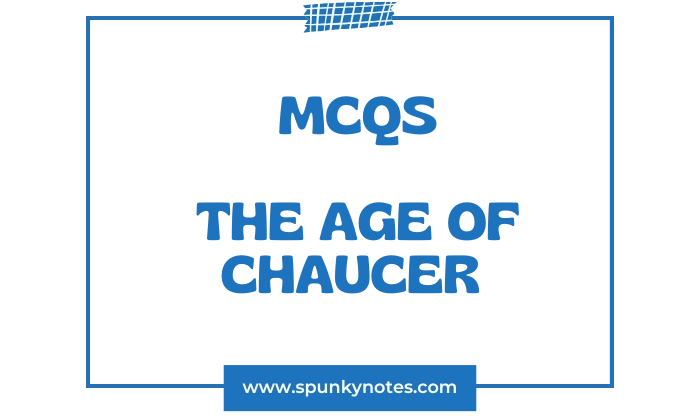
Geoffrey Chaucer MCQs
1. When was Geoffrey Chaucer born?
A. 1340
B. 1357
C. 1342/43
D. 1366
2. When did Geoffrey Chaucer die?
A. 1387
B. October 25, 1400
C. 1434
D. 1399
3. Where was Geoffrey Chaucer buried after his death?
A. Canterbury Cathedral
B. The Tower of London
C. Westminster Palace
D. Westminster Abbey
4. Which title did Chaucer receive from critics, acknowledging his linguistic contribution to English poetry?
A. The Father of English Verse
B. The First Modern Poet
C. The first finder of our language
D. The Master of Middle English
5. Which significant status did Chaucer hold in English poetry before William Shakespeare?
A. Minor figure
B. Preeminent English poet
C. Regional London poet
D. Pioneer of the sonnet
6. What was the occupation of Chaucer’s father, John Chaucer?
A. Lawyer and political officeholder
B. London moneyer
C. Vintner and deputy to the king’s butler
D. Master of the royal mint
7. The Chaucer family’s financial success was primarily derived from which two industries?
A. Banking and wool
B. Wine and leather
C. Farming and trading
D. Military contracts and gold
8. The family name Chaucer is derived from the French word chaussier, meaning a maker of what?
A. Saddles
B. Footwear
C. Wine barrels
D. Diplomatic seals
9. Chaucer’s mother, Agnes Copton, was the niece and heiress of which type of London officer?
A. A Sheriff
B. A Vintner
C. A Moneyer
D. A Justice of the Peace
10. In what year does Chaucer first appear in public records, as a member of the house of Elizabeth, Countess of Ulster?
A. 1340
B. 1357
C. 1366
D. 1374
11. Chaucer’s writings demonstrate a close familiarity with which important philosophical work?
A. Aristotle’s Ethics
B. Boethius’s The Consolation of Philosophy
C. Virgil’s Aeneid
D. Plato’s Republic
12. Which three languages, besides Middle English, was Chaucer likely fluent or competent in?
A. German, Spanish, Greek
B. French, Italian, Latin
C. Dutch, Portuguese, Arabic
D. Old English, Norse, Hebrew
13. The arrangement of placing sons of middle-class households in royal service was conventional for obtaining what?
A. Military training
B. A university degree
C. A courtly education
D. Immediate wealth
14. During his early life (1359), Chaucer served in the army under which king?
A. Henry IV
B. Richard II
C. Edward III
D. William the Conqueror
15. Where was Chaucer captured during a military offensive in 1359?
A. Calais
B. Milan
C. Reims
D. Antwerp
16. By what year had Chaucer married Philippa Pan?
A. 1357
B. 1360
C. 1366
D. 1374
17. Through his marriage, Chaucer was related to which powerful nobleman?
A. Richard II
B. Edward III
C. Duke of Suffolk
D. Duke of Lancaster
18. Chaucer served under a number of what types of missions during his career?
A. Military and siege
B. Diplomatic
C. Educational reform
D. Religious conversion
19. During his diplomatic missions in the 1370s, Chaucer traveled to Italy and encountered the work of which three highly influential writers?
A. Plato, Cicero, Ovid
B. Dante, Petrarch, Boccaccio
C. Shakespeare, Marlowe, Spenser
D. Virgil, Horace, Livy
20. Chaucer’s first major office away from the British court was Comptroller of the Customs and Subsidy of wool, skins, and tanned hides for the Port of London, appointed in what year?
A. 1366
B. 1370
C. 1374
D. 1380
21. What political title did Chaucer hold for Kent, requiring him to attend Parliament in October 1386?
A. Sheriff
B. Duke of the Shire
C. Knight of the Shire
D. Royal Messenger
22. Chaucer apparently moved to Greenwich, and later Kent, around the time of whose death in 1387?
A. Edward III
B. John of Gaunt
C. Queen Philippa
D. Philippa Chaucer (his wife)
23. Which important public office did Chaucer hold from July 1389 to June 1391?
A. Comptroller of the Customs
B. Justice of the Peace
C. Subforester of North Petherton
D. Clerk of the King’s Works
24. What was Chaucer’s first published work, a poem of over 1,300 lines?
A. The Canterbury Tales
B. Troilus and Criseyde
C. The Book of the Duchess
D. House of Fame
25. The Book of the Duchess is supposed to be an elegy for whom?
A. Queen Philippa
B. Elizabeth, Countess of Ulster
C. Blanche, Duchess of Lancaster
D. Criseyde
26. Which of Chaucer’s poems is a dream-vision written for St. Valentine’s Day?
A. House of Fame
B. The Legend of Good Women
C. Parlement of Foules
D. The Book of the Duchess
27. Which 8,000-line poem had its plot partly taken from Boccaccio’s Filostrato?
A. The Book of the Duchess
B. The Canterbury Tales
C. Troilus and Criseyde
D. House of Fame
28. What prose work did Chaucer translate, which discussed free will and destiny?
A. Dante’s Inferno
B. Boethius’s The Consolation of Philosophy
C. Ovid’s Metamorphoses
D. Petrarch’s Sonnets
29. Which later work showed Chaucer experimenting with a framing device for a collection of stories?
A. The House of Fame
B. The Legend of Good Women
C. Parlement of Foules
D. Treatise on the Astrolabe
30. Which of Chaucer’s works is considered his masterpiece and fills his third, or English, period?
A. The Legend of Good Women
B. The House of Fame
C. Thé Canterbury Tales
D. Troilus and Criseyde
31. The frame story of The Canterbury Tales involves pilgrims traveling to which shrine?
A. Shrine of St. Edmund
B. Shrine of John of Gaunt
C. Shrine of Thomas a Becket in Canterbury
D. Shrine of St. Valentine
32. How many pilgrims, including Chaucer himself, are drawn together for the purpose of The Canterbury Tales?
A. Thirty-two
B. Forty-eight
C. Thirty
D. Twenty
33. From which inn in Southwark do the pilgrims set off on their journey in The Canterbury Tales?
A. The Boar’s Head Inn
B. The George Inn
C. Thé Mermaid Tavern
D. The Tabard Inn
34. How many tales did the host propose each pilgrim tell on the journey to and from Canterbury?
A. One on the way, one on the way back
B. Four total, without specifying direction
C. Two on the way, two on the way back
D. One total
35. How many tales did Chaucer actually complete for The Canterbury Tales?
A. Thirty-two
B. Twenty-four
C. More than one hundred
D. One hundred and twenty-eight
36. What is the name of Chaucer’s long prose treatise on the seven deadly sins, which concludes The Canterbury Tales?
A. The Monk’s Tale
B. The Parson’s Tale
C. Thé Knight’s Tale
D. The Tale of Melibeus
37. The Canterbury Tales concludes with a passage asking for forgiveness. What is this section called?
A. The Epilogue
B. The Pardoner’s Prologue
C. The Retraction
D. The General Prologue
38. What is the name given to the seven-lined stanza (ababbcc) popularized by Chaucer, also known as the Chaucerian stanza?
A. Spenserian Stanza
B. Terza Rima
C. Rhyme Royal
D. Ottava Rima
39. What is a notable characteristic of Chaucer’s humour?
A. It is always overtly satirical and denouncing.
B. It is rich, intellectual, and touches on life’s incongruities kindly.
C. It is dry and cynical, often lacking in warmth.
D. It is primarily based on slapstick and exaggeration.
40. Which of the following is not a primary source of material for Chaucer’s poems?
A. Classical legends
B. Invented stories from his own imagination
C. Italian works
D. French narratives
41. How does Chaucer compare to other medieval writers in terms of originality?
A. He copied works directly without adaptation.
B. He never used existing material.
C. Hé reshaped material from the contemporary store, reflecting his age’s ideals.
D. He always invented entirely new stories.
42. For whom did Chaucer compose his Treatise on the Astrolabe?
A. His patron, John of Gaunt
B. A group of Oxford scholars
C. His little son, Lewis
D. King Richard II
43. What does Lowell name as the chief quality represented by Chaucer among great English poets?
A. Imaginative life
B. Actual life
C. Interior life
D. Ideal life
44. What literary virtue is highlighted as very prominent in Chaucer’s work, stemming from his wide experience?
A. Acute faculty of observation
B. Abstract symbolism
C. Strict adherence to classical rules
D. Exaggerated bitterness
45. Chaucer’s mastery in The Canterbury Tales is exemplified by its portrayal of:
A. Primarily royal and noble life.
B. Mostly religious and monastic life.
C. The struggles of the lowest classes exclusively.
D. A wide sweep of contemporary English life, its work and play, deeds and dreams, fun and sympathy.
46. Who was Chaucer’s contemporary and friend, often considered his rival in English eloquence?
A. William Langland
B. John Wyclif
C. Sir John Mandeville
D. John Gower
47. Who is the author of The Vision Concerning Piers the Plowman?
A. John Wyclif
B. William Langland
C. John Gower
D. Geoffrey Chaucer
48. What historical figure is central to the questioning of religious institutions in the late 14th century?
A. William of Ockham
B. John Lydgate
C. John Wyclif (or Wycliffe)
D. St. Thomas a Becket
49. What was John Wyclif’s chief contribution from a literary perspective?
A. His responsibility for the earliest translation of the entire Bible from Latin into English.
B. Composing courtly romances
C. Writing satirical poems
D. Developing a new poetic meter.
50. What invention, introduced by William Caxton in 1476, drastically increased the speed and reduced the cost of book production?
A. The movable type printing press
B. The paper mill
C. Thé telegraph
D. The quill pen
Brief Overview
The Age of Chaucer refers to the last part of the 14th century in England. This period is named after its most important writer, Geoffrey Chaucer. He is often called the “Father of English Literature” because he chose to write in English, not French or Latin, which was common.
This was a time of great change and trouble in England. The country was dealing with the Black Death, a terrible plague that killed many people. There was also a lot of social unrest, like the Peasants’ Revolt, and religious conflict with figures like John Wycliffe.
Chaucer worked as a courtier and civil servant, which allowed him to see many different parts of society. His most famous work is The Canterbury Tales. This is a collection of stories told by a diverse group of pilgrims traveling together.
The Canterbury Tales is famous for its vivid and realistic characters. Chaucer wrote about knights, nuns, merchants, and poor farmers, showing a full picture of life in the late Middle Ages. His work established English as a great language for poetry and storytelling.

